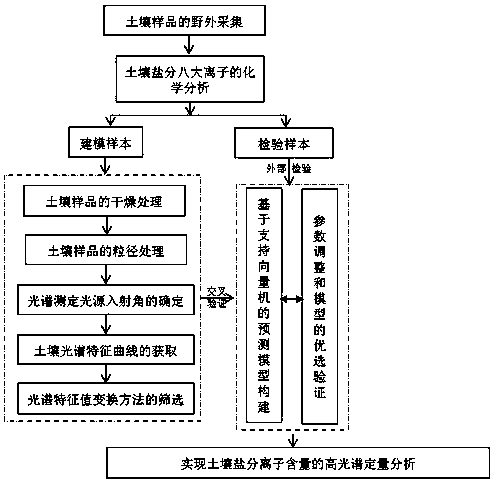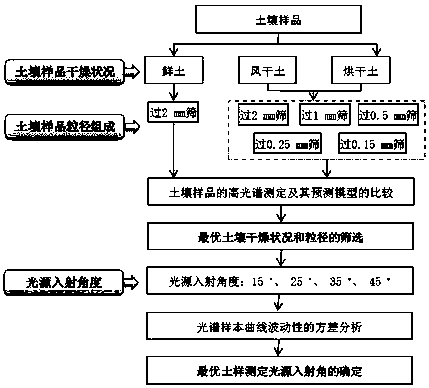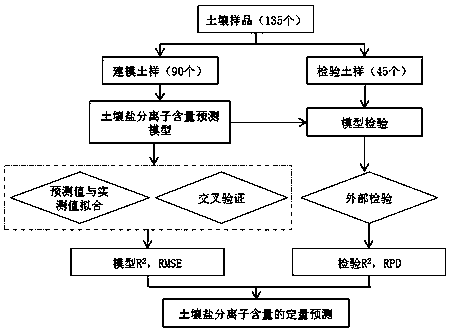Monitoring method of salt ion content in salinized soil based on hyperspectral technology
An ion content and hyperspectral technology, applied in the field of rapid monitoring of soil salinity, can solve the problems of obvious influence of hyperspectral measurement, lack of good comparison, unclear hyperspectral quantitative inversion of soil salt ions, and simple operation steps. , the effect of low cost
- Summary
- Abstract
- Description
- Claims
- Application Information
AI Technical Summary
Problems solved by technology
Method used
Image
Examples
Embodiment 1
[0042] Such as figure 1 As shown, Step 1: Select a typical area representing the local salinity situation, select points with similar surface conditions in the same sampling area, collect soil samples at a thickness of 0-5 cm on the soil surface, and mix the collected soil samples evenly before packaging quickly In a ziplock bag, and record the latitude and longitude of the soil sample collection point;
[0043] Step 2: Remove impurities other than the soil from the soil sample retrieved in Step 1, and divide the removed soil sample into three parts. The first part of the soil sample, soil sample A, is ground and passed through a 2mm sieve, and sieved The final soil sample is numbered and packed in a ziplock bag, and then the ziplock bag is stored in the refrigerator; the second soil sample B of the soil sample is taken to dry naturally; the second soil sample C of the soil sample is placed in an oven at 105-110 °C Bake to constant weight;
[0044] Step 3: Pass the soil samp...
Embodiment 2
[0076] Concrete sampling on the basis of embodiment one is as follows:
[0077] (1) Acquisition of soil samples: In order to obtain more salinity gradients of natural soil samples, according to the distribution of salinized farmland in the study area, 0-5 soil surface layers of heavily, moderately and lightly salinized farmland were collected from April to October. cm soil samples, select 5 points with similar surface conditions (surrounding vegetation, soil color, roughness, and mass water content <15%) at the same sampling location, use GPS to record the latitude and longitude of the sample points, mix the samples evenly and quickly package them in a self-sealing A total of 203 soil samples were collected in the study area.
[0078] (2) Remove plant residues, stones and other impurities from the retrieved fresh soil samples, and dry them in an oven at 105-110°C until they reach a constant weight.
[0079] (3) The dried soil sample was ground through a 0.15 mm sieve, and 50 ...
PUM
 Login to View More
Login to View More Abstract
Description
Claims
Application Information
 Login to View More
Login to View More - R&D
- Intellectual Property
- Life Sciences
- Materials
- Tech Scout
- Unparalleled Data Quality
- Higher Quality Content
- 60% Fewer Hallucinations
Browse by: Latest US Patents, China's latest patents, Technical Efficacy Thesaurus, Application Domain, Technology Topic, Popular Technical Reports.
© 2025 PatSnap. All rights reserved.Legal|Privacy policy|Modern Slavery Act Transparency Statement|Sitemap|About US| Contact US: help@patsnap.com



